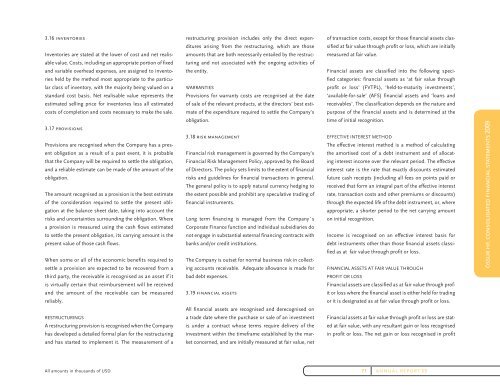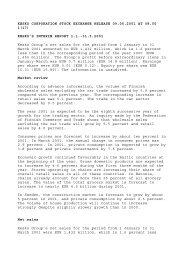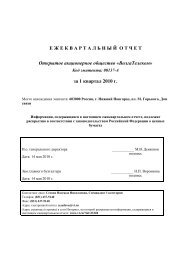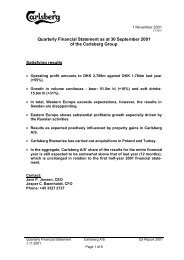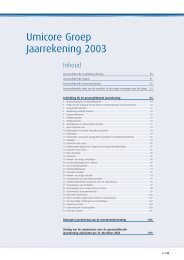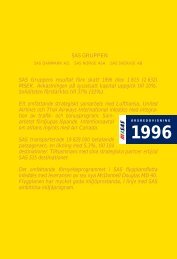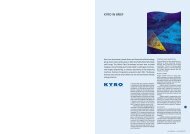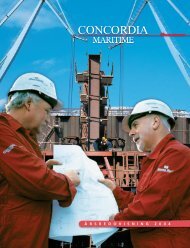össur annual report2009 - Euroland
össur annual report2009 - Euroland
össur annual report2009 - Euroland
Create successful ePaper yourself
Turn your PDF publications into a flip-book with our unique Google optimized e-Paper software.
3.16 inventories<br />
Inventories are stated at the lower of cost and net realisable<br />
value. Costs, including an appropriate portion of fixed<br />
and variable overhead expenses, are assigned to inventories<br />
held by the method most appropriate to the particular<br />
class of inventory, with the majority being valued on a<br />
standard cost basis. Net realisable value represents the<br />
estimated selling price for inventories less all estimated<br />
costs of completion and costs necessary to make the sale.<br />
3.17 provisions<br />
Provisions are recognised when the Company has a present<br />
obligation as a result of a past event, it is probable<br />
that the Company will be required to settle the obligation,<br />
and a reliable estimate can be made of the amount of the<br />
obligation.<br />
The amount recognised as a provision is the best estimate<br />
of the consideration required to settle the present obligation<br />
at the balance sheet date, taking into account the<br />
risks and uncertainties surrounding the obligation. Where<br />
a provision is measured using the cash flows estimated<br />
to settle the present obligation, its carrying amount is the<br />
present value of those cash flows.<br />
When some or all of the economic benefits required to<br />
settle a provision are expected to be recovered from a<br />
third party, the receivable is recognised as an asset if it<br />
is virtually certain that reimbursement will be received<br />
and the amount of the receivable can be measured<br />
reliably.<br />
RESTRUCTURINGS<br />
A restructuring provision is recognised when the Company<br />
has developed a detailed formal plan for the restructuring<br />
and has started to implement it. The measurement of a<br />
restructuring provision includes only the direct expenditures<br />
arising from the restructuring, which are those<br />
amounts that are both necessarily entailed by the restructuring<br />
and not associated with the ongoing activities of<br />
the entity.<br />
WARRANTIES<br />
Provisions for warranty costs are recognised at the date<br />
of sale of the relevant products, at the directors’ best estimate<br />
of the expenditure required to settle the Company’s<br />
obligation.<br />
3.18 risk ManageMent<br />
Financial risk management is governed by the Company’s<br />
Financial Risk Management Policy, approved by the Board<br />
of Directors. The policy sets limits to the extent of financial<br />
risks and guidelines for financial transactions in general.<br />
The general policy is to apply natural currency hedging to<br />
the extent possible and prohibit any speculative trading of<br />
financial instruments.<br />
Long term financing is managed from the Company´s<br />
Corporate Finance function and individual subsidiaries do<br />
not engage in substantial external financing contracts with<br />
banks and/or credit institutions.<br />
The Company is outset for normal business risk in collecting<br />
accounts receivable. Adequate allowance is made for<br />
bad debt expenses.<br />
3.19 financial assets<br />
All financial assets are recognised and derecognised on<br />
a trade date where the purchase or sale of an investment<br />
is under a contract whose terms require delivery of the<br />
investment within the timeframe established by the market<br />
concerned, and are initially measured at fair value, net<br />
of transaction costs, except for those financial assets classified<br />
at fair value through profit or loss, which are initially<br />
measured at fair value.<br />
Financial assets are classified into the following specified<br />
categories: financial assets as ‘at fair value through<br />
profit or loss’ (FvTPL), ‘held-to-maturity investments’,<br />
‘available-for-sale’ (AFS) financial assets and ‘loans and<br />
receivables’. The classification depends on the nature and<br />
purpose of the financial assets and is determined at the<br />
time of initial recognition.<br />
EFFECTIvE INTEREST METHOD<br />
The effective interest method is a method of calculating<br />
the amortised cost of a debt instrument and of allocating<br />
interest income over the relevant period. The effective<br />
interest rate is the rate that exactly discounts estimated<br />
future cash receipts (including all fees on points paid or<br />
received that form an integral part of the effective interest<br />
rate, transaction costs and other premiums or discounts)<br />
through the expected life of the debt instrument, or, where<br />
appropriate, a shorter period to the net carrying amount<br />
on initial recognition.<br />
Income is recognised on an effective interest basis for<br />
debt instruments other than those financial assets classified<br />
as at fair value through profit or loss.<br />
FINANCIAL ASSETS AT FAIR vALUE THROUGH<br />
PROFIT OR LOSS<br />
Financial assets are classified as at fair value through profit<br />
or loss where the financial asset is either held for trading<br />
or it is designated as at fair value through profit or loss.<br />
Financial assets at fair value through profit or loss are stated<br />
at fair value, with any resultant gain or loss recognised<br />
in profit or loss. The net gain or loss recognised in profit<br />
All amounts in thousands of USD 71 <strong>annual</strong> report 09<br />
Össur hf. consolidated financial stateMents 2009


